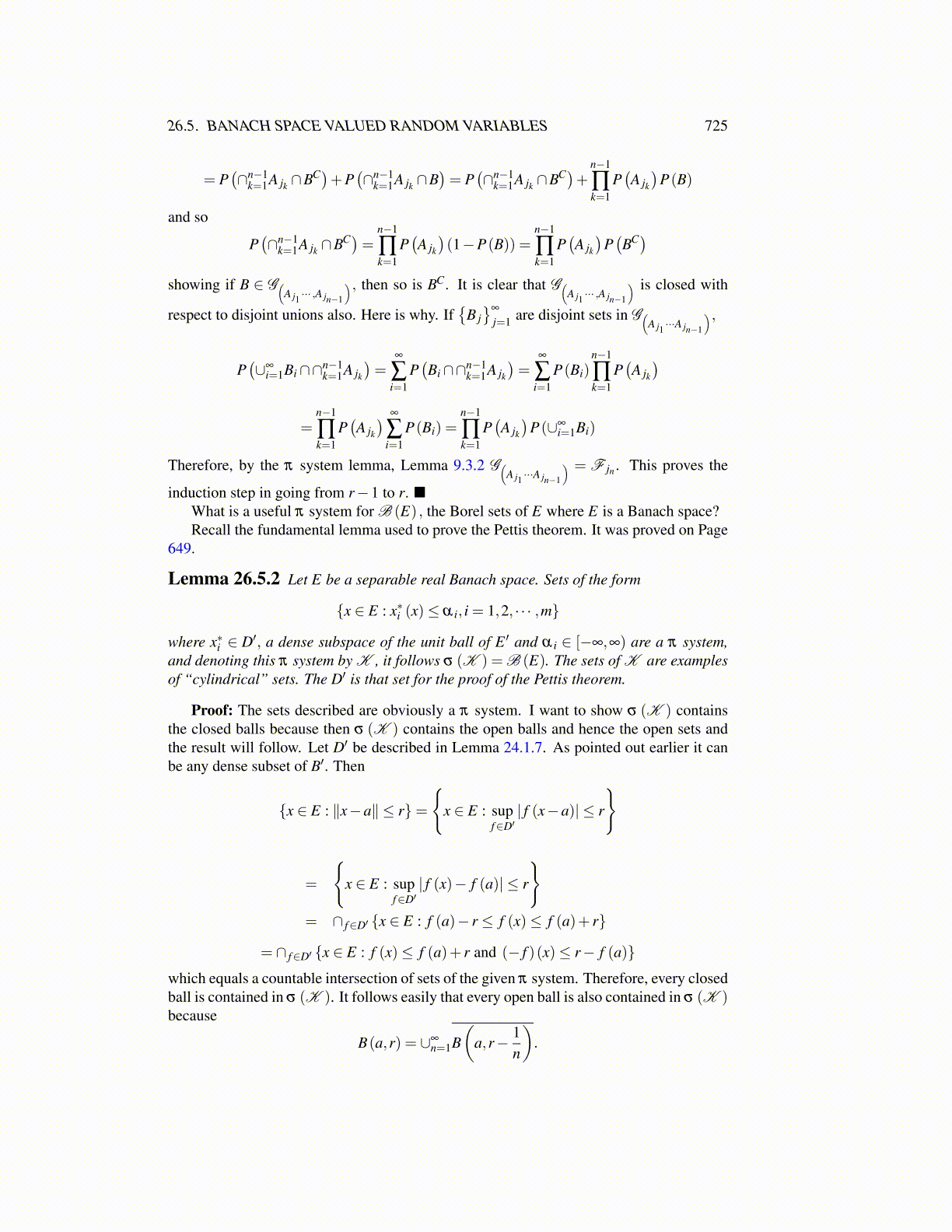
26.5. BANACH SPACE VALUED RANDOM VARIABLES 725
= P(∩n−1
k=1A jk ∩BC)+P(∩n−1
k=1A jk ∩B)= P
(∩n−1
k=1A jk ∩BC)+ n−1
∏k=1
P(A jk
)P(B)
and so
P(∩n−1
k=1A jk ∩BC)= n−1
∏k=1
P(A jk
)(1−P(B)) =
n−1
∏k=1
P(A jk
)P(BC)
showing if B ∈ G(A j1 ··· ,A jn−1
), then so is BC. It is clear that G(A j1 ··· ,A jn−1
) is closed with
respect to disjoint unions also. Here is why. If{
B j}∞
j=1 are disjoint sets in G(A j1 ···A jn−1
),
P(∪∞
i=1Bi∩∩n−1k=1A jk
)=
∞
∑i=1
P(Bi∩∩n−1
k=1A jk
)=
∞
∑i=1
P(Bi)n−1
∏k=1
P(A jk
)=
n−1
∏k=1
P(A jk
) ∞
∑i=1
P(Bi) =n−1
∏k=1
P(A jk
)P(∪∞
i=1Bi)
Therefore, by the π system lemma, Lemma 9.3.2 G(A j1 ···A jn−1
) = F jn . This proves the
induction step in going from r−1 to r. ■What is a useful π system for B (E) , the Borel sets of E where E is a Banach space?Recall the fundamental lemma used to prove the Pettis theorem. It was proved on Page
649.
Lemma 26.5.2 Let E be a separable real Banach space. Sets of the form
{x ∈ E : x∗i (x)≤ α i, i = 1,2, · · · ,m}
where x∗i ∈ D′, a dense subspace of the unit ball of E ′ and α i ∈ [−∞,∞) are a π system,and denoting this π system by K , it follows σ (K ) = B (E). The sets of K are examplesof “cylindrical” sets. The D′ is that set for the proof of the Pettis theorem.
Proof: The sets described are obviously a π system. I want to show σ (K ) containsthe closed balls because then σ (K ) contains the open balls and hence the open sets andthe result will follow. Let D′ be described in Lemma 24.1.7. As pointed out earlier it canbe any dense subset of B′. Then
{x ∈ E : ∥x−a∥ ≤ r}=
{x ∈ E : sup
f∈D′| f (x−a)| ≤ r
}
=
{x ∈ E : sup
f∈D′| f (x)− f (a)| ≤ r
}= ∩ f∈D′ {x ∈ E : f (a)− r ≤ f (x)≤ f (a)+ r}
= ∩ f∈D′ {x ∈ E : f (x)≤ f (a)+ r and (− f )(x)≤ r− f (a)}which equals a countable intersection of sets of the given π system. Therefore, every closedball is contained in σ (K ). It follows easily that every open ball is also contained in σ (K )because
B(a,r) = ∪∞n=1B
(a,r− 1
n
).